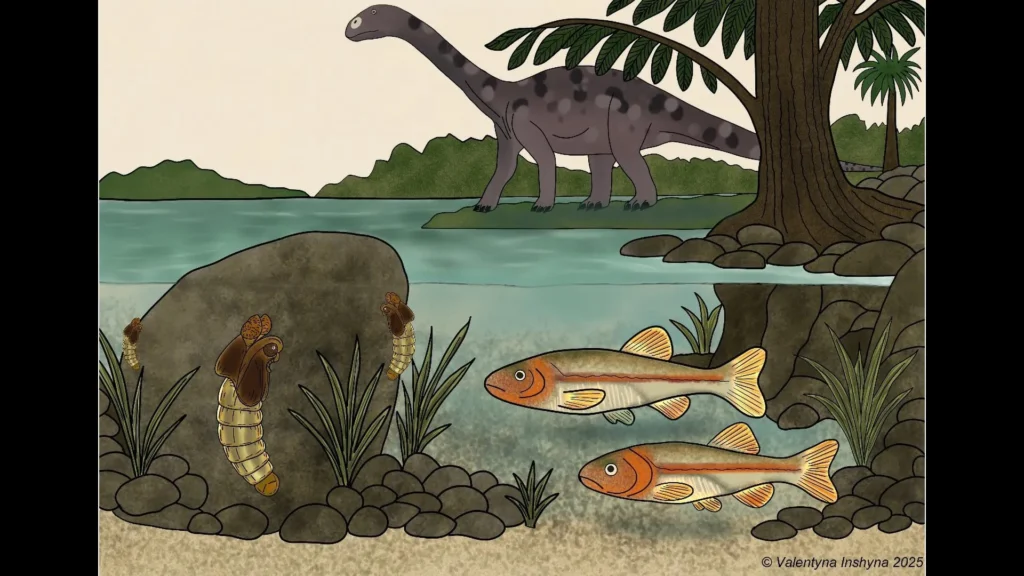An international group of researchers led by the Doñana Biological Station (EBD-CSIC) has identified a previously unknown species of fossilized insect from the Jurassic period in Australia, estimated to be about 151 million years old. This discovery marks the oldest known member of the Chironomidae family found in the Southern Hemisphere. These non-biting midges typically live in freshwater environments. The fossil reveals a remarkable evolutionary feature: a structure that likely helped the insect attach securely to rocks. Until now, such an anchoring mechanism had only been documented in marine organisms.
The fossil was uncovered in the Talbragar fish beds in New South Wales. The study, published in the journal Gondwana Research, involved experts from the Australian Museum Research Institute, the University of New South Wales, the University of Munich, and Massey University in New Zealand.
The fly from the stagnant waters
“This fossil, which is the oldest registered find in the Southern Hemisphere, indicates that this group of freshwater animals might have originated on the southern supercontinent of Gondwana,” explains Viktor Baranov, a researcher at the Doñana Biological Station and first author of the study.
The newly identified species was named Telmatomyia talbragarica, meaning “fly from the stagnant waters,” a nod to the lake-like setting of the Talbragar region.
Researchers examined six fossilized specimens, including pupae and emerging adults, all showing the presence of a terminal disc. This structure, known to function in environments affected by tides, was once believed to be limited to marine species. However, sediment and fossil evidence from Talbragar indicate that the area was once a freshwater habitat, demonstrating the surprising adaptability (phenotypic plasticity) of chironomids.
Rethinking the origins of the family
The Podonominae group has long served as a valuable model for studying how species are distributed across the planet and how biodiversity arises over time.
Earlier theories suggested that Podonominae originated in northern Gondwana before spreading northward into Laurasia, the ancient landmass that included today’s Northern Hemisphere continents. Their fossil record, however, is limited, partly because of preservation challenges and a lack of studies focusing on Southern Hemisphere specimens. Later discoveries of older fossils in Eurasia, dating back to the Jurassic, prompted some scientists to propose a Laurasian origin instead.
The new findings challenge that view, offering strong evidence that the Podonominae subfamily most likely began in the Southern Hemisphere and later expanded worldwide.
Today, Podonominae species are found mostly in the Southern Hemisphere. Their scattered distribution across South America, Australia, South Africa, and New Zealand is a classic case of vicariance — a process in which natural barriers such as mountains or rivers divide a population, forcing each group to evolve independently and form new species. Swedish entomologist Lars Brundin first proposed in 1966 that the breakup of the ancient supercontinent Gondwana triggered this evolutionary separation.
Limitations due to the scarcity of fossils in the Southern Hemisphere
While this discovery addresses a significant gap in the lineage’s fossil record, a comprehensive understanding of this group’s evolutionary history is still limited by the lack of Southern Hemisphere fossils. The majority of known Podonominae fossils originate from the Northern Hemisphere, with only two prior exceptions documented from the Southern Hemisphere: an Eocene specimen from Australia and a Paleocene record from India.
There is a strong bias towards finding and studying fossils in the Northern Hemisphere. Because of this we end up making incorrect assumptions about where groups originated,” explains Matthew McCurry, palaeontologist from the Australian Museum and The University of New South Wales.
Professor in Massey University Steve Trewick claims, “there are long-standing questions about the way Southern Hemisphere biotas formed and changed through geological time. Fossils species of tiny, delicate freshwater insects like the Talbragar fly are rare and help us interpret the history of life on our planet.”
The analysis of the fossilized specimens, combined with genomics, will help determine whether the dispersal of these insects after the breakup of Gondwana was primarily passive or active. The resulting data will certainly be of value for comprehending and conserving modern-day biodiversity.

